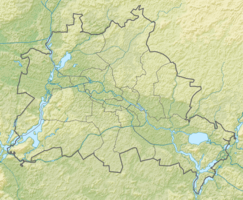Grain park
| Grain park | ||
|---|---|---|
| Park in Berlin | ||

|
||
| View from the orangery onto the park with water stairs, 2012 | ||
| Basic data | ||
| place | Berlin | |
| District | Neukölln | |
| Created | until 1916 | |
| Newly designed | from 1977 | |
| Surrounding streets | Jonasstrasse, Schierker Strasse, Selkestrasse, Wittmannsdorfer Strasse |
|
| Buildings | Orangery | |
| use | ||
| User groups | Pedestrian traffic , leisure | |
| Technical specifications | ||
| Parking area | 240,000 m² | |
|
52 ° 28 '19 " N , 13 ° 26' 16" E
|
||
The Körnerpark green area is located in the Neukölln district of Berlin in the district of the same name . The approximately 2.4 hectare large park resembles a castle park: In addition to water features (including fountains ) is found in the western part of the Orangery , which houses a café and a gallery for temporary exhibitions. The forecourt of the orangery is used for various events in summer. A flower garden is laid out in the northern part.
Emergence
The park was laid out in a former gravel pit that the owner Franz Körner gave to the then town of Rixdorf in 1910 . The only condition was that the park had to bear his name. The park, which was probably designed by H. R. Küllenberg and built between 1912 and 1916 in the neo-baroque style, should, according to the will of the city fathers, "give the surrounding city quarter a particularly decorative character and encourage the implementation of an exceptionally beautiful renovation and the creation of a particularly preferred residential area . "
Due to its previous use as a gravel pit, the area is five to seven meters lower than the surrounding street level and is surrounded on three sides by retaining walls. Similar to Versailles , the orangery designed by Reinhold Kiehl is leaning against the western wall . In addition to the fairy tale fountain in Volkspark Friedrichshain and the cascade at Lietzensee , the Körnerpark is the most important example of neo-baroque garden design in Berlin.
Restoration
Because the park was directly in the approach lane until the closure of Tempelhof Airport in 2008, it was becoming increasingly neglected.
Nevertheless, from 1977 onwards, the district office had started to restore the horticultural facilities on the basis of existing documents. The cascade system and the canals were renovated. There are now potted plants again on the terrace in front of the orangery, and the abundant shrubs have been renewed.
The Körnerpark has been a listed building since April 2, 2004 .
Equestrian grave of Neukölln

The terrain became archaeological prominence when on 23 January 1912 at the corner jonas- Selke road during construction work, the equestrian grave of Neukölln was found. The grave dates from the time of the Great Migration in the 5th and 6th centuries.
Rider and horse were housed in a crypt 2.50 meters deep. The dead male, who died around 40 years old, was buried with his horse. Remains of a leather belt shod with iron parts, bronze nails and a clay pot were also found in this horse burial. A long sword ( spathe ) lay across the body of the dead man.
literature
- HR Küllenberg: The Körnerpark in Neukölln. In: Die Gartenkunst No. 3/1919, pp. 29–31.
- Adrian von Müller: Berlin's prehistory . Bruno Hessling Verlag, Berlin 1971, ISBN 3-7769-0111-X , p. 58.
- Clemens Alexander Wimmer: Parks and Gardens in Berlin and Potsdam ; ed. Senator for Urban Development and Environmental Protection, Dept. III - Garden Monument Preservation; Nicolaische Verlagsbuchhandlung: 3rd edition, Berlin 1989, ISBN 3-87584-267-7 , pp. 80–82.
- Sabine Huth, Cordula Rinsche: Palaces, parks & gardens in Berlin and Brandenburg . FAB Verlag, Berlin 1997, ISBN 3-927551-40-6 , p. 226.
Web links
Individual evidence
- ↑ Garden monument Körnerpark
- ^ The Germanic equestrian grave ( memento of August 8, 2014 in the Internet Archive ), accessed on April 18, 2012.

